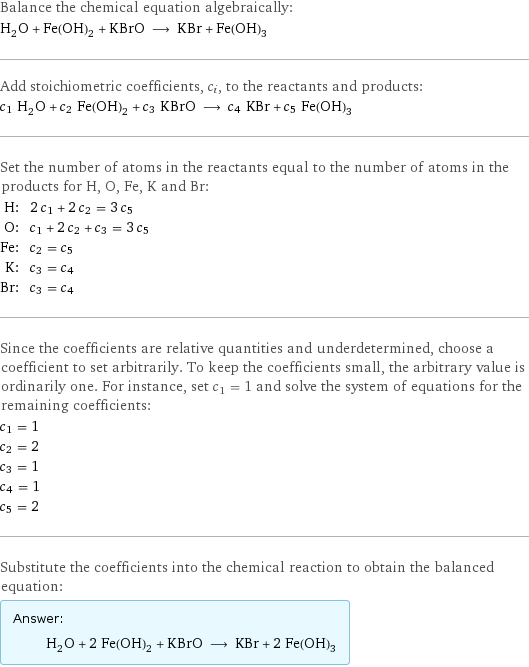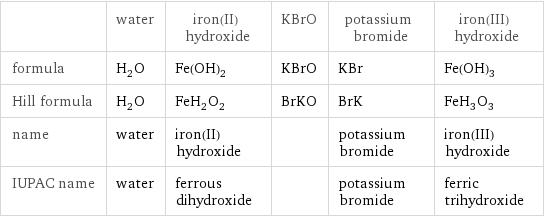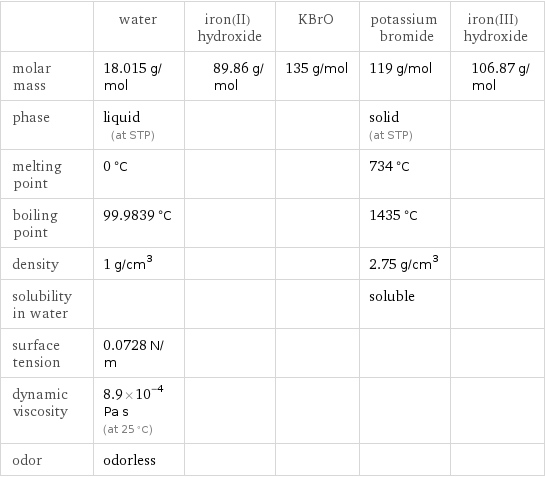Input interpretation

H_2O water + Fe(OH)_2 iron(II) hydroxide + KBrO ⟶ KBr potassium bromide + Fe(OH)_3 iron(III) hydroxide
Balanced equation

Balance the chemical equation algebraically: H_2O + Fe(OH)_2 + KBrO ⟶ KBr + Fe(OH)_3 Add stoichiometric coefficients, c_i, to the reactants and products: c_1 H_2O + c_2 Fe(OH)_2 + c_3 KBrO ⟶ c_4 KBr + c_5 Fe(OH)_3 Set the number of atoms in the reactants equal to the number of atoms in the products for H, O, Fe, K and Br: H: | 2 c_1 + 2 c_2 = 3 c_5 O: | c_1 + 2 c_2 + c_3 = 3 c_5 Fe: | c_2 = c_5 K: | c_3 = c_4 Br: | c_3 = c_4 Since the coefficients are relative quantities and underdetermined, choose a coefficient to set arbitrarily. To keep the coefficients small, the arbitrary value is ordinarily one. For instance, set c_1 = 1 and solve the system of equations for the remaining coefficients: c_1 = 1 c_2 = 2 c_3 = 1 c_4 = 1 c_5 = 2 Substitute the coefficients into the chemical reaction to obtain the balanced equation: Answer: | | H_2O + 2 Fe(OH)_2 + KBrO ⟶ KBr + 2 Fe(OH)_3
Structures

+ + KBrO ⟶ +
Names

water + iron(II) hydroxide + KBrO ⟶ potassium bromide + iron(III) hydroxide
Equilibrium constant
![Construct the equilibrium constant, K, expression for: H_2O + Fe(OH)_2 + KBrO ⟶ KBr + Fe(OH)_3 Plan: • Balance the chemical equation. • Determine the stoichiometric numbers. • Assemble the activity expression for each chemical species. • Use the activity expressions to build the equilibrium constant expression. Write the balanced chemical equation: H_2O + 2 Fe(OH)_2 + KBrO ⟶ KBr + 2 Fe(OH)_3 Assign stoichiometric numbers, ν_i, using the stoichiometric coefficients, c_i, from the balanced chemical equation in the following manner: ν_i = -c_i for reactants and ν_i = c_i for products: chemical species | c_i | ν_i H_2O | 1 | -1 Fe(OH)_2 | 2 | -2 KBrO | 1 | -1 KBr | 1 | 1 Fe(OH)_3 | 2 | 2 Assemble the activity expressions accounting for the state of matter and ν_i: chemical species | c_i | ν_i | activity expression H_2O | 1 | -1 | ([H2O])^(-1) Fe(OH)_2 | 2 | -2 | ([Fe(OH)2])^(-2) KBrO | 1 | -1 | ([KBrO])^(-1) KBr | 1 | 1 | [KBr] Fe(OH)_3 | 2 | 2 | ([Fe(OH)3])^2 The equilibrium constant symbol in the concentration basis is: K_c Mulitply the activity expressions to arrive at the K_c expression: Answer: | | K_c = ([H2O])^(-1) ([Fe(OH)2])^(-2) ([KBrO])^(-1) [KBr] ([Fe(OH)3])^2 = ([KBr] ([Fe(OH)3])^2)/([H2O] ([Fe(OH)2])^2 [KBrO])](../image_source/395af659a6ddca25325a4c419fe2bf74.png)
Construct the equilibrium constant, K, expression for: H_2O + Fe(OH)_2 + KBrO ⟶ KBr + Fe(OH)_3 Plan: • Balance the chemical equation. • Determine the stoichiometric numbers. • Assemble the activity expression for each chemical species. • Use the activity expressions to build the equilibrium constant expression. Write the balanced chemical equation: H_2O + 2 Fe(OH)_2 + KBrO ⟶ KBr + 2 Fe(OH)_3 Assign stoichiometric numbers, ν_i, using the stoichiometric coefficients, c_i, from the balanced chemical equation in the following manner: ν_i = -c_i for reactants and ν_i = c_i for products: chemical species | c_i | ν_i H_2O | 1 | -1 Fe(OH)_2 | 2 | -2 KBrO | 1 | -1 KBr | 1 | 1 Fe(OH)_3 | 2 | 2 Assemble the activity expressions accounting for the state of matter and ν_i: chemical species | c_i | ν_i | activity expression H_2O | 1 | -1 | ([H2O])^(-1) Fe(OH)_2 | 2 | -2 | ([Fe(OH)2])^(-2) KBrO | 1 | -1 | ([KBrO])^(-1) KBr | 1 | 1 | [KBr] Fe(OH)_3 | 2 | 2 | ([Fe(OH)3])^2 The equilibrium constant symbol in the concentration basis is: K_c Mulitply the activity expressions to arrive at the K_c expression: Answer: | | K_c = ([H2O])^(-1) ([Fe(OH)2])^(-2) ([KBrO])^(-1) [KBr] ([Fe(OH)3])^2 = ([KBr] ([Fe(OH)3])^2)/([H2O] ([Fe(OH)2])^2 [KBrO])
Rate of reaction
![Construct the rate of reaction expression for: H_2O + Fe(OH)_2 + KBrO ⟶ KBr + Fe(OH)_3 Plan: • Balance the chemical equation. • Determine the stoichiometric numbers. • Assemble the rate term for each chemical species. • Write the rate of reaction expression. Write the balanced chemical equation: H_2O + 2 Fe(OH)_2 + KBrO ⟶ KBr + 2 Fe(OH)_3 Assign stoichiometric numbers, ν_i, using the stoichiometric coefficients, c_i, from the balanced chemical equation in the following manner: ν_i = -c_i for reactants and ν_i = c_i for products: chemical species | c_i | ν_i H_2O | 1 | -1 Fe(OH)_2 | 2 | -2 KBrO | 1 | -1 KBr | 1 | 1 Fe(OH)_3 | 2 | 2 The rate term for each chemical species, B_i, is 1/ν_i(Δ[B_i])/(Δt) where [B_i] is the amount concentration and t is time: chemical species | c_i | ν_i | rate term H_2O | 1 | -1 | -(Δ[H2O])/(Δt) Fe(OH)_2 | 2 | -2 | -1/2 (Δ[Fe(OH)2])/(Δt) KBrO | 1 | -1 | -(Δ[KBrO])/(Δt) KBr | 1 | 1 | (Δ[KBr])/(Δt) Fe(OH)_3 | 2 | 2 | 1/2 (Δ[Fe(OH)3])/(Δt) (for infinitesimal rate of change, replace Δ with d) Set the rate terms equal to each other to arrive at the rate expression: Answer: | | rate = -(Δ[H2O])/(Δt) = -1/2 (Δ[Fe(OH)2])/(Δt) = -(Δ[KBrO])/(Δt) = (Δ[KBr])/(Δt) = 1/2 (Δ[Fe(OH)3])/(Δt) (assuming constant volume and no accumulation of intermediates or side products)](../image_source/11d7eb24a7a8e8360f52387ad7ed7cba.png)
Construct the rate of reaction expression for: H_2O + Fe(OH)_2 + KBrO ⟶ KBr + Fe(OH)_3 Plan: • Balance the chemical equation. • Determine the stoichiometric numbers. • Assemble the rate term for each chemical species. • Write the rate of reaction expression. Write the balanced chemical equation: H_2O + 2 Fe(OH)_2 + KBrO ⟶ KBr + 2 Fe(OH)_3 Assign stoichiometric numbers, ν_i, using the stoichiometric coefficients, c_i, from the balanced chemical equation in the following manner: ν_i = -c_i for reactants and ν_i = c_i for products: chemical species | c_i | ν_i H_2O | 1 | -1 Fe(OH)_2 | 2 | -2 KBrO | 1 | -1 KBr | 1 | 1 Fe(OH)_3 | 2 | 2 The rate term for each chemical species, B_i, is 1/ν_i(Δ[B_i])/(Δt) where [B_i] is the amount concentration and t is time: chemical species | c_i | ν_i | rate term H_2O | 1 | -1 | -(Δ[H2O])/(Δt) Fe(OH)_2 | 2 | -2 | -1/2 (Δ[Fe(OH)2])/(Δt) KBrO | 1 | -1 | -(Δ[KBrO])/(Δt) KBr | 1 | 1 | (Δ[KBr])/(Δt) Fe(OH)_3 | 2 | 2 | 1/2 (Δ[Fe(OH)3])/(Δt) (for infinitesimal rate of change, replace Δ with d) Set the rate terms equal to each other to arrive at the rate expression: Answer: | | rate = -(Δ[H2O])/(Δt) = -1/2 (Δ[Fe(OH)2])/(Δt) = -(Δ[KBrO])/(Δt) = (Δ[KBr])/(Δt) = 1/2 (Δ[Fe(OH)3])/(Δt) (assuming constant volume and no accumulation of intermediates or side products)
Chemical names and formulas

| water | iron(II) hydroxide | KBrO | potassium bromide | iron(III) hydroxide formula | H_2O | Fe(OH)_2 | KBrO | KBr | Fe(OH)_3 Hill formula | H_2O | FeH_2O_2 | BrKO | BrK | FeH_3O_3 name | water | iron(II) hydroxide | | potassium bromide | iron(III) hydroxide IUPAC name | water | ferrous dihydroxide | | potassium bromide | ferric trihydroxide
Substance properties

| water | iron(II) hydroxide | KBrO | potassium bromide | iron(III) hydroxide molar mass | 18.015 g/mol | 89.86 g/mol | 135 g/mol | 119 g/mol | 106.87 g/mol phase | liquid (at STP) | | | solid (at STP) | melting point | 0 °C | | | 734 °C | boiling point | 99.9839 °C | | | 1435 °C | density | 1 g/cm^3 | | | 2.75 g/cm^3 | solubility in water | | | | soluble | surface tension | 0.0728 N/m | | | | dynamic viscosity | 8.9×10^-4 Pa s (at 25 °C) | | | | odor | odorless | | | |
Units
